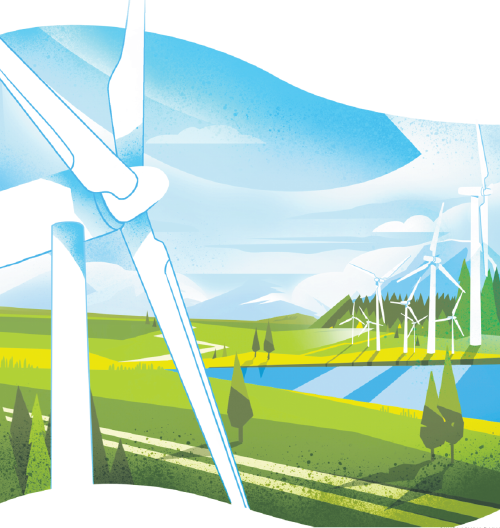Planned intent

China's climate ambition is a call for actions by countries to realize green transformation

President Xi Jinping announced at the 75th session of the United Nations General Assembly on Sept 22 that "China will scale up its nationally determined contributions and adopt more vigorous policies and measures, strive to peak carbon dioxide emissions before 2030, and achieve carbon neutrality before 2060".
Less than three months later, on Dec 12, President Xi elaborated further on China's climate ambitions at the global Climate Ambition Summit. "By 2030, China will lower its carbon dioxide emissions per unit of GDP by over 65 percent from the 2005 level, increase the share of non-fossil fuels in primary energy consumption to around 25 percent, increase the forest stock volume by 6 billion cubic meters from the 2005 level, and bring its total installed capacity of wind and solar power to over 1.2 billion kilowatts," he said.
First, the climate ambition, with the core goal of substantially reducing carbon intensity, is very important for the comprehensive green transformation of China's economic and social development, the core mission being to actively reduce the climate and environmental risks by taking measures that can protect the ecological environment.
China has set "significantly reducing carbon intensity" as its core climate ambition according to its national conditions, which embodies the concept of achieving coordinated development of the environment and the economy.
In the new era, there is no contradiction between climate change and economic development.
On the one hand, it is necessary to promote the high-quality development of our society and economy while coping with climate change. On the other hand, social and economic development should also achieve the goals of low-carbonization and sustainability. China's new climate ambition was announced at a critical moment when the economy was beginning to recover after being hit by the outbreak of the novel coronavirus.
Second, the focus of the climate ambition is on mitigation and adaptation.
To realize its climate ambition, China must rely on two approaches, namely switching to non-fossil energy and increasing its forest coverage. Switching to non-fossil energy will optimize the energy structure, while more forest will increase the carbon sink.
Therefore, the climate mitigation goal relies fundamentally on carbon emissions reduction, to achieve the carbon peak in the mid-term and carbon neutrality ultimately.
In other words, we need to assimilate climate mitigation into every aspect of social and economic development by focusing on low-carbon lifestyles, the low-carbon economy and finance, and low-carbon technology and products, and other things. The ultimate goal is to realize the practical decoupling of our social and economic development from carbon emissions. In the process, our economic and social development should also take account of the climate adaptation simultaneously, and reduce various social and economic losses caused by climate change before fully achieving carbon neutrality and mitigation of climate change.
Third, the climate ambition takes account of the efficiency and fairness of comprehensive green transformation. In order to mitigate climate change, a comprehensive green transformation must take account of both efficiency and equity.
On the one hand, the path for China realizing its climate ambition is very clear, that is, to allow the market to play an actively decisive role in allocating various climate mitigation resources.
Since it has been clarified that industrial developments such as new energy and energy efficiency technologies are effective approaches to mitigate climate change, we should actively advance the green economy and introduce green finance innovations, focusing on the development gaps in the new energy and the energy efficiency technologies.
Those gaps are in the fields of production capacity, technology, investment and so on. Therefore, we should mobilize resources and capital to invest in climate mitigation, so as to improve efficiency.
At the same time, to achieve the climate ambition, the government must unify emissions reduction standards, improve emissions reduction information disclosure, and correctly guide social capital to emissions reduction.
On the other hand, from the perspective of the international community, realizing carbon neutrality requires all countries to work together, do their best, follow the principle of common but differentiated responsibilities, and strengthen actions to the greatest extent, which are based on national conditions and capabilities. In particular, the developed countries must earnestly increase the provision of funds, technology, and capacity building support to the developing countries to fulfill their commitments.
Last but not least, the connotation and goals of the climate ambitions will help shape China's 14th Five-Year Plan (2021-25).There are only two five-year plans till 2030, the deadline for peaking China's carbon emissions. Therefore, the 14th Five-Year Plan will be a critical stage for realizing the climate ambitions. It can be anticipated that adjustment of the energy structure, development of climate investment and financing, construction of the climate mitigation system and climate adaptation initiatives will be among the top priorities in the 14th Five-Year Plan.
The author is the executive director of the Center for Environmental Economic Studies at Fudan University. The author contributed this article to China Watch, a think tank powered by China Daily. The views do not necessarily reflect those of China Daily.
If you have a specific expertise and would like to contribute to China Daily, please contact us at opinion@chinadaily.com.cn, and comment@chinadaily.com.cn.


































